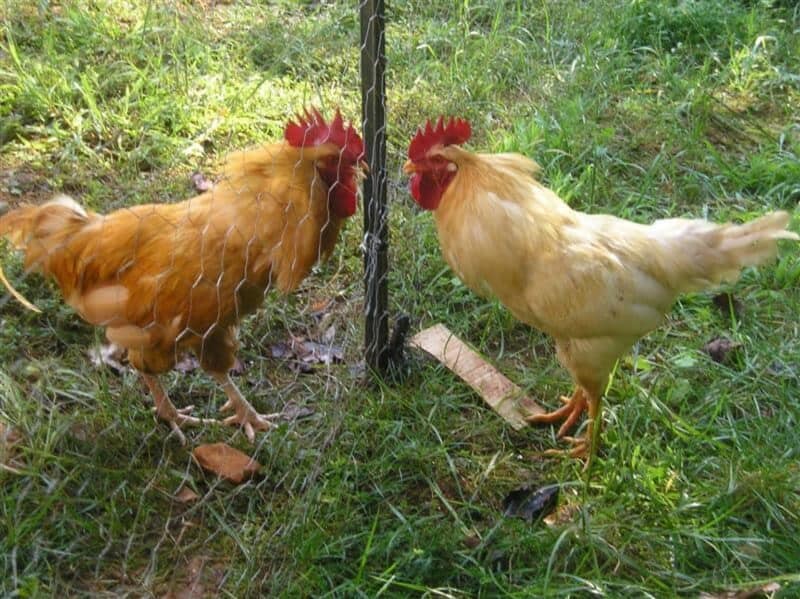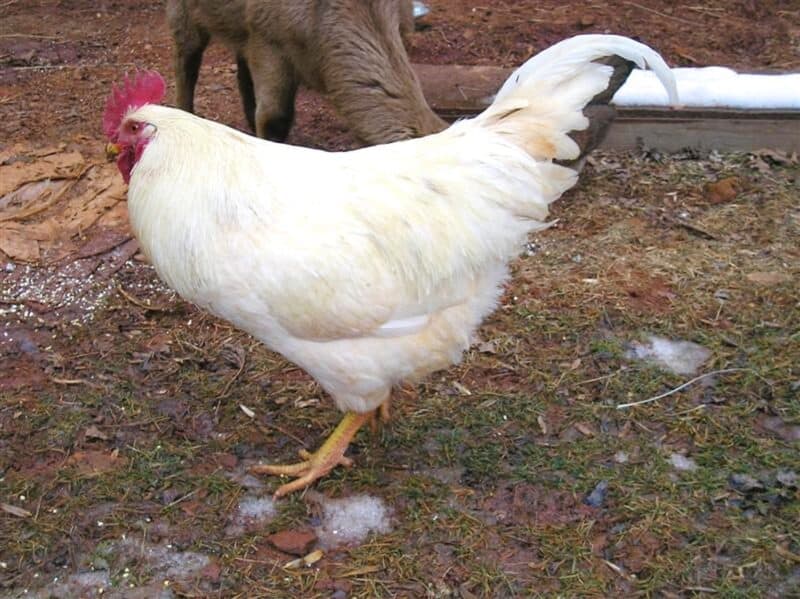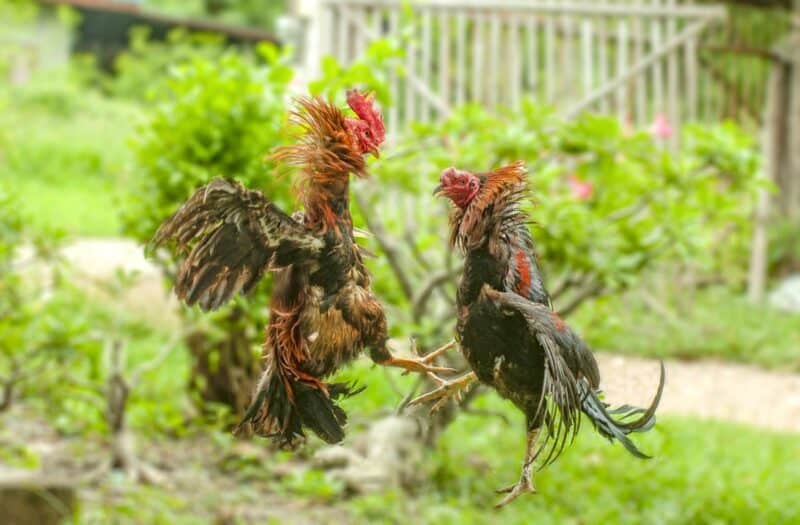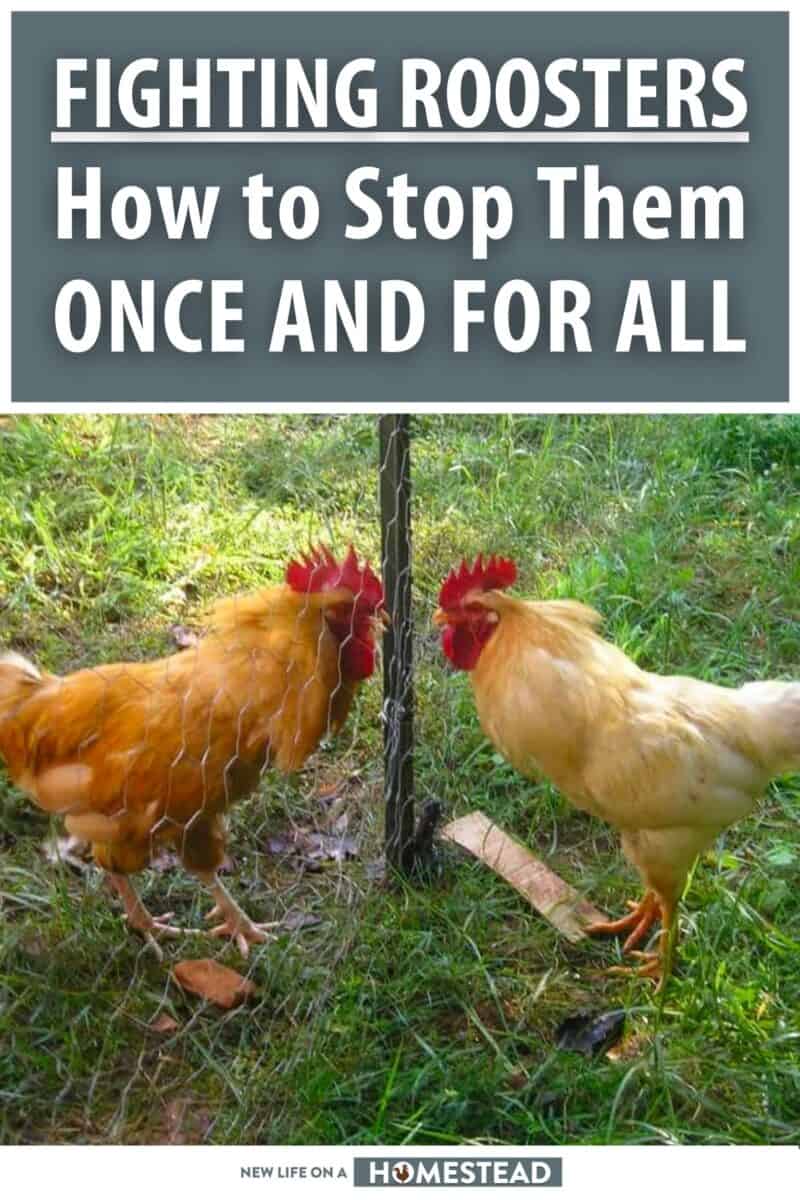Keeping chickens can be a fun hobby and rewarding venture, but it can sometimes be hard to keep the roosters from fighting each other.

These willful males play an important role in keeping a flock orderly and safe from predators but that doesn’t matter when they are tearing each other to shreds!
There are several factors that influence when roosters fight, including territory, resources, and hierarchy- the literal pecking order.
To prevent or end fights between your roosters once and for all, you have to think about these underlying causes of conflict. Whatever their reasons, fighting roosters can stress out your flock, resulting in more injuries and fewer eggs.
With the right approach, it’s possible to keep roosters from fighting or at the very least minimize the fighting that seemingly has to happen.
We’ll go through the reasons why roosters fight and give you some solutions for preventing it in this article. With a little luck and plenty of diligence, your flock can peck around peacefully. Let’s get going.

What Factors Contribute to Roosters Fighting?
If you’ve never witnessed a fight between two roosters, let me tell you, it is an extraordinarily violent sight to behold.
The two birds will typically face off on an open patch of ground and let out a series of loud crows and clucks as they size each other up.
Then one rooster will go in for the first attack, bobbing its head, flapping and pecking at the other bird with its beak, and slicing with its sharp claws and spurs.
If the other rooster shows fight it will retaliate with quick jabs of its own, striking back at its opponent repeatedly until one of them tires out, wears down, and gives up.
In the end, only one bird will emerge victorious; but regardless of the outcome, both roosters will undoubtedly emerge with plenty of battle scars as a reminder of the encounter.
Sometimes, one rooster will have had enough of the loser and try to finish them off or exile them from the flock.
Roosters are brutal! This violence is disconcerting to be sure, and can be traumatizing if you keep chickens mostly as pets, but it is simply a part of chicken “society” more or less.
Understanding the underlying motivators can help you keep a lid on the worst of the fighting.
One of the most common reasons why roosters fight is over a general lack of food and water in their habitat or a perceived lack.
If your chickens aren’t getting enough to eat or drink, it can be frustrating for the birds, and when resources are scarce, fighting between roosters is common.
Similarly, if you give them plenty of food and water, but only in one spot, the physical pressure of all of the birds trying to access these resources at once can also lead to fighting.
In short, if your roosters feel like they’re being deprived in some way, they may start picking fights with each other as a way to assert themselves and secure resources.
Another significant factor that contributes to fighting is the hierarchy. Roosters are hardwired to establish dominance and place themselves at the top of their flock’s “pecking order”.
In most cases, this is established vigorously when there are hens present in a flock. The dominant rooster will naturally seek to exert his authority over the subordinate roosters.
They establish this hierarchy by fighting each other, and eventually one will submit to the other’s dominance and then the cycle continues, down the hierarchy, until every rooster knows where it stands among the others.
Regardless of where a rooster is in the flock hierarchy, fights are assured if there are not enough hens for the roosters to have a harem to themselves.
Generally, you will want about 10 hens for every rooster, though some species or individuals will need more or less.
And lastly, it must be said that some roosters are just ornery. Mean. Nasty.
These troublesome individuals have a general disposition that compels them to start fights with other roosters.
If you have one of these “bad eggs” in your flock, it may be best to remove him from the rest for their safety and your sanity!
Now that you know some of the most common underlying factors that contribute to rooster fights, we can talk about some ways to manage and prevent them. Keep reading for proven methods on how to get your roosters to settle down.
Solutions for Stopping Fights between Your Roosters
You can separate the methods below into two broad categories: holistic solutions and reductive solutions.
Holistic solutions seek to keep the roosters living among the rest of the flock as productive and important members.
Reductive solutions only aim to solve the problem by any means necessary, usually removing the offending bird or birds.
Both approaches are worthwhile. Both work. It is totally up to you to decide and apply based on your circumstances and desires.
Holistic Solutions
Make Sure the Flock Has Enough Space
All chickens need space to forage and exercise, and if they don’t have enough it can lead to frustrations that result in fighting.
This behavior is especially common in roosters. You just cannot pack those rowdy boys into too small a space!
If your roosters are cooped up in a small run with little room to move around, they will feel more discontented and territorial, leading them to pick fights with each other.
However, by giving your roosters plenty of space to roam and move around, you can help to reduce the frequency of these behaviors.
In addition to providing your flock with ample room to move around, it’s important to ensure that they also have sufficient room around feeder stations and their own places to roost.
Giving your roosters plenty of space and “fresh air” can help keep their frustration levels at bay and minimize fighting.
Increase the Number of Hens in the Flock
Rooster fights are very common when there are few females in a flock and too many male birds.
Each and every rooster wants a company of hens just for himself, and if he perceives his fellow roosters as competing for a limited number of ladies, the feathers will fly.
If you only have one or two roosters in your flock, it might not be too bad, but larger flocks with multiple roosters and too few hens means you’ll have a veritable war on your hands and it likely will not end until the “ratio” is restored by the death or exiling of weaker roosters.
The lack of hens leads to frustrations that can only be settled through fighting.
So, as an easy preventative measure, always make sure that you balance your flocks to give your roosters plenty of hens. This way they don’t feel the need to fight over mating rights.
You should plan on having about 10 hens for every rooster – though this number can vary depending on the species and the individual as mentioned above.
Just remember: the more hens, the better behavior you can expect from your roosters.
Make Sure the Flock has Enough Food and Water
Roosters are especially prone to fighting when they feel that their food and water sources are being threatened.
If there isn’t enough food to go around, or if one bird is getting at the food while another can’t, it will lead to problems.
This is especially true when you have a rooster who is dominating the food or water and bullying others in the flock.
If this alpha rooster perceives that he is being challenged over precious resources, he will try to reassert his dominance through violence and fighting. These fights to keep the lesser birds “in line” also have a tendency to get quite nasty.
To combat this tendency, make sure that your flock always has access to a plentiful food and water supply.
Try not to cramp their feeder/water space, or rearrange their feeding locations too frequently- either of these can lead to roosters perceiving as though resources are scarce or unpredictable, leading to, you guessed it, more fights!
Use Multiple Stations for Food and Water
As a corollary to the previous entry, make it a point to employ multiple stations for both food and water.
Aside from making it far more obvious that there is plenty of both to go around this will also allow roosters and hens alike to spread out when they eat, reducing physical pressure and proximity.
Roosters in particular naturally desire to spread out from one another and this method will play into that psychology wonderfully.
Even if you don’t have a lot of birds, it could be very helpful to set up multiple stations throughout the flock’s usual area in order to give everyone ample opportunity to feed and drink without piling atop one another.

Let them Fight it Out
This is bound to be the most contentious entry on the whole list. Despite the dread some rooster owners may feel at the prospect, allowing them to fight it out might be the best thing you can do to slow or stop fighting.
I want to take the time to explain this reasoning thoroughly so no one reading thinks I am just advocating for a “law of the jungle” approach.
Roosters will almost always fight and bicker among themselves in order to establish a dominant hierarchy within the flock. Think of this like figuring out who is going to be in charge of all the roosters.
You cannot have more than one king, after all! One rooster will rule, and the other will be subordinate.
In the case of multiple roosters, you’ll have an alpha, the lieutenant as it were, and a bunch of underlings.
Roosters instinctively sort this out among themselves because they do work together in order to protect the flock as a whole.
Accordingly, don’t interfere in what nature has decreed. The trick for you, as their owner or keeper, is to recognize the intensity of the fight, and to be prepared to swoop in and act when things become too heated.
You’ll also have to patch up your birds, winner, and loser after the dust settles.
Rooster fights are often battles for social standing, and rank, in which the roosters face off and square up.
As mentioned above, they may crow and flap their wings, peck, claw, and flog each other but they won’t typically attempt to genuinely kill their opponent.
These incidents usually come to a close when one rooster gives up and the winner gets to walk around showing off his prowess for a bit.
While these fights appear dramatic, usually injuries are few and minor, though you must watch out when a smaller bird decides to tackle a bigger one.
But some fights are serious. Serious in the old ways: to the death! In these instances, one rooster will attack another without stopping, even after the loser attempts to flee or gives up.
The winner will press the attack, trying to severely injure or kill the loser.
These fights are ugly: at best, you’ll have two severely injured roosters with a better than average chance of one of them winding up dead or dying.
In most situations, chicken pecking order competitions are a natural factor of flock life that may be permitted in the interests of balancing the flock. The hardcore fights for blood should, however, be ended at once.
If you have roosters fighting to the death on a regular basis, you may need to split them up into different coops to avoid one or both being maimed or killed.
Reductive Solutions
Separate the Roosters from the Rest of the Flock
Whatever the cause may be, whatever the variables, sometimes roosters just can’t play nice with the hens or with each other, or you just don’t have the time or will to solve the problem.
You have other things to deal with after all!
As we have mentioned, roosters are supposed to be aggressive and incorrigible. They are the protectors of the flock! But when kept together with the flock, they may just stay on “high alert”.
The mildest reductive solution to overcome this problem is to move the roosters in altogether but completely separate from the hens.
It’s drastic, but in return the hens will be generally much happier without all of the fighting going on so they can get back to laying.
Surprisingly, with the “hen factor” out of the equation, many roosters will cohabitate well if their basic needs are still met.
They might squabble to establish hierarchy, as normal, but much of the worst fighting should subside.
However, you must fulfill one critical requirement in order for this technique to succeed: You must make certain, absolutely certain, that the roosters cannot see or hear the hens.
They very much want to be with the girls, and they will become even more agitated than usual if they can sense them but cannot get to them.
Get Rid of the Bad Bird
Sadly, sometimes you’ll have a rooster that is just cut from a different cloth. Maybe he is hyper-vigilant. Maybe he won’t take no for an answer from other roosters. Maybe he is just hateful. The other roosters fear and hate him. You are fed up with him.
If this describes your situation, you may have to remove the rooster entirely or try and find someone who will take this devil’s minion off of your hands.
This doesn’t necessarily imply you have to get rid of him permanently. You could simply remove him from the flock for good or re-home him in a completely separate flock.
Maybe his behavior will improve without the other roosters he once lived with. New latitudes, new attitudes, like the song says.
But, the troublesome rooster may still be sold or given away, with the notion that getting rid of him completely will stabilize the flock and bring about peace.
This must be done judiciously and ethically, however, because a potential new owner must be made to understand that they are purchasing a troublemaker. You wouldn’t want him repeating his bad behavior elsewhere!
Some people choose to “stew pot” troublemaker roosters, either as a last (or first) resort.
This way, the old grump can give up his meat to help you and your family in a way he never did during his hateful life.
Do keep in mind, if you have a family and keep your chickens as pets, this will certainly be traumatizing if they find out where the meat came from!
Roosters are Going to Fight, but You Can Stop It
No matter what you do, some level of fighting is going to occur among your roosters. It’s simply their nature.
However, with a little bit of effort on your part, you can minimize the bloodshed and make life much more peaceful for both the hens and the roosters. You have several proven options, now, and there is sure to be a few that can help you.

Tom has lived and worked on farms and homesteads from the Carolinas to Kentucky and beyond. He is passionate about helping people prepare for tough times by embracing lifestyles of self-sufficiency.

Your pics don’t want to load for me. Would have been interested to see them.
Amy,
It looks like NONE of my photos are showing right now. Hopefully it’s something WordPress will fix soon!! Thanks for letting me know.
I have buff orpington roosters, and I’ve been shocked at how visciously the fight with one another. I got them because they are supposed to be some of the most docile of the dual purpose breeds. They have never offered to attack a human, but boy, are the mean to each other!